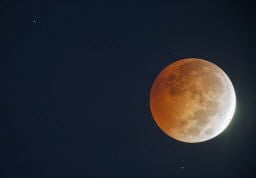NASA will live stream the lunar eclipse via the Mt. Lemmon SkyCenter Wednesday.
The center says on its Facebook page that the link is https://www.nasa.gov/nasalive
UPDATE: Check out stunning photos of the eclipse here
In addition to the SkyCenter, views will come from telescopes at NASA's Armstrong Flight Research Center in Edwards, California and Griffith Observatory in Los Angeles, says the post.
At about 6:30 a.m., Tucsonans can look into the western sky and catch a reddened full moon caught in the center of Earth’s shadow.
The spectacle will hover less than 10 degrees above the western horizon at that time, which could make it hard to see if mountains are in your line of sight.
For reference, use an old amateur astronomer’s trick: The width of a clenched fist held at arm’s length to the sky covers about 10 degrees. Hold it up to the horizon and the moon should be about that high in the sky.
No special equipment or precautions are needed to view the eclipse.
That’s just the peak of the eclipse. Since the Earth’s shadow is larger than the moon, the eclipse will last for more than an hour, starting at 5:51 a.m. and ending at 7:07 a.m. The earlier you’re out, the better the view.
During the total eclipse, the moon, the second full moon of January, will have a reddish hue because of the way the atmosphere manipulates light.
The sun emits all colors of light, making it appear white. Like sunsets, when sunlight passes through Earth’s atmosphere, blue light is scattered while red light is bent into Earth’s shadow — meaning the lunar surface is lit by the diffuse glow of Earth’s sunsets.
If you want in on the action leading up to the total lunar eclipse, pour a cup of coffee, grab a jacket and head out at 4:48 a.m. when the dark core of Earth’s shadow, called the umbra, begins sliding across the moon’s surface.
The moon will be higher at that time — about 30 degrees, or three fist widths, above the horizon.
Die-hard eclipse-watchers should head out at 3:51 a.m., when the Earth’s penumbra, the partial shadow of our planet, begins crossing the moon’s surface.
Even with a clear horizon, which is rare in Tucson, the show ends at 7:20 a.m. when the moon sets.
About the same time next year, Monday, Jan. 21, another total lunar eclipse will traverse the Tucson sky that can been seen from start to finish.





